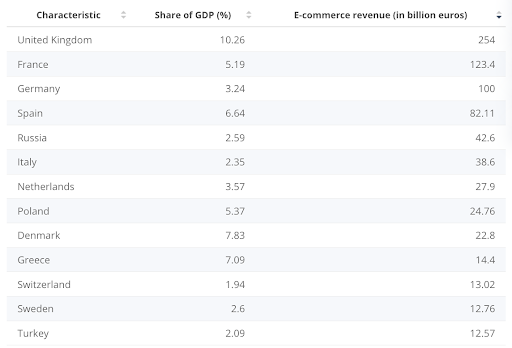Table of contents
Introduction
Europe is usually the first cross-border destination for UK eCommerce brands. And no wonder given the close proximity and huge size of the market. In 2023, for instance, there will be over 540 million European consumers shopping online.
But it’s only a viable market if brands get their strategy right. In this article, we analyze the potential of the cross-border European eCommerce market and cover some of the strategies you can use to make the move successful.
The Rise of European Cross-Border Commerce
When eCommerce brands enter the European market, they access consumers from 27 of the most affluent countries in the world. The continent is home to 14 of the top 20 countries ranked by GDP per capita.
What’s more, European consumers love to shop online. In 2022, B2C commerce in Europe was valued at $500 billion, with over 500 million users shopping online spending an average of $948 each.
Even despite Brexit, there’s never been a better time for UK retailers to sell online to consumers living on the continent.

The Opportunities and Challenges of Cross-Border Trade in Europe
European consumers are far from hesitant about making online purchases from brands located outside their country. Research shows that 30% of consumers made purchases from other EU member states in 2021. Further, the total value of online EU cross-border purchases was €171 billion in 2021.
Unfortunately, setting up shop in Europe isn’t as straightforward as it used to be. It’s vital UK merchants understand the challenges they may face when selling across borders into Europe and the steps they need to take to overcome them.
Offer the Right Payment Methods
The online payment methods you offer to consumers in the UK may not be a perfect match with European customers. Residents in different countries across Europe have different payment preferences, so it’s vital to understand which methods consumers prefer in your target markets.
For instance, Belgian shoppers overwhelmingly prefer Bancontact, while German consumers prefer PayPal and BNPL services like Klarna.
Understanding which payment methods you need to offer is one thing, facilitating them is another. Merchants will need to choose a payment gateway or eCommerce platform that provides the methods consumers demand without charging exorbitant fees.
Localise the Experience
You can’t launch an EU-version of your website written in English and expect customers to flock to it. Unlike North America, English is far from the predominant language on the continent. That means you have to think carefully about how you want to localise the consumer experience and translate your website in particular.
A common strategy is to focus on a handful of the largest European markets. France, Germany and Spain are the largest markets by some distance.
So only translating your website into French, German and Spanish may be a viable solution. That will help you localise the experience for the biggest markets without necessarily putting off visitors from smaller markets. Dutch shoppers, for instance, may be happy to shop German or English versions of a website.

Make Delivery Count
Like payment options, consumer delivery preferences also differ from country to country across Europe. For example, consumers in France, Spain and Italy make a point of choosing when and how a product is delivered during checkout, while consumers from the Netherlands, Germany and the Nordic region don’t place as much importance on this factor.
Pick Up, Drop Off (PUDO) and Click and Collect preferences also vary across the continent. In Scandinavia, PUDO is the number one delivery method. It’s favoured by French and Spanish consumers, too.
Offering the right delivery options at checkout is, therefore, key to cross-border success. Don’t think European customers are the same as UK consumers and make sure you have a range of delivery options to suit local tastes.
Clear Customs With Ease
There’s no doubt about it; Brexit has created more hurdles for cross-border trade between the UK and Europe. But those hurdles are not insurmountable, you just need to know how to get over or around them.
Part of that is working with an experienced third-party logistics partner who can help you navigate all of the added customs documentation you now need to sell into Europe.
But merchants also need to understand specialist eCommerce services like the newly created Import-One-Stop-Shop (IOSS) VAT procedure. This scheme allows retailers to significantly simplify VAT payment by reporting and paying VAT in a single EU country, regardless of where they sell. This scheme is only available to products valued at €150 or less and VAT must be collected prior to delivery.
Pro Carrier is Your Partner for European Cross-Border Commerce
We created Pro Carrier to take the complexity of cross-border commerce. Our experts make it easy to sell into the continent, handling every aspect of customs so you don’t have to. Plus our network of last-mile delivery partners means you can offer all of the delivery options your European customers expect.
Find out more about Pro Carrier or get started shipping to the continent today by speaking to an expert.



